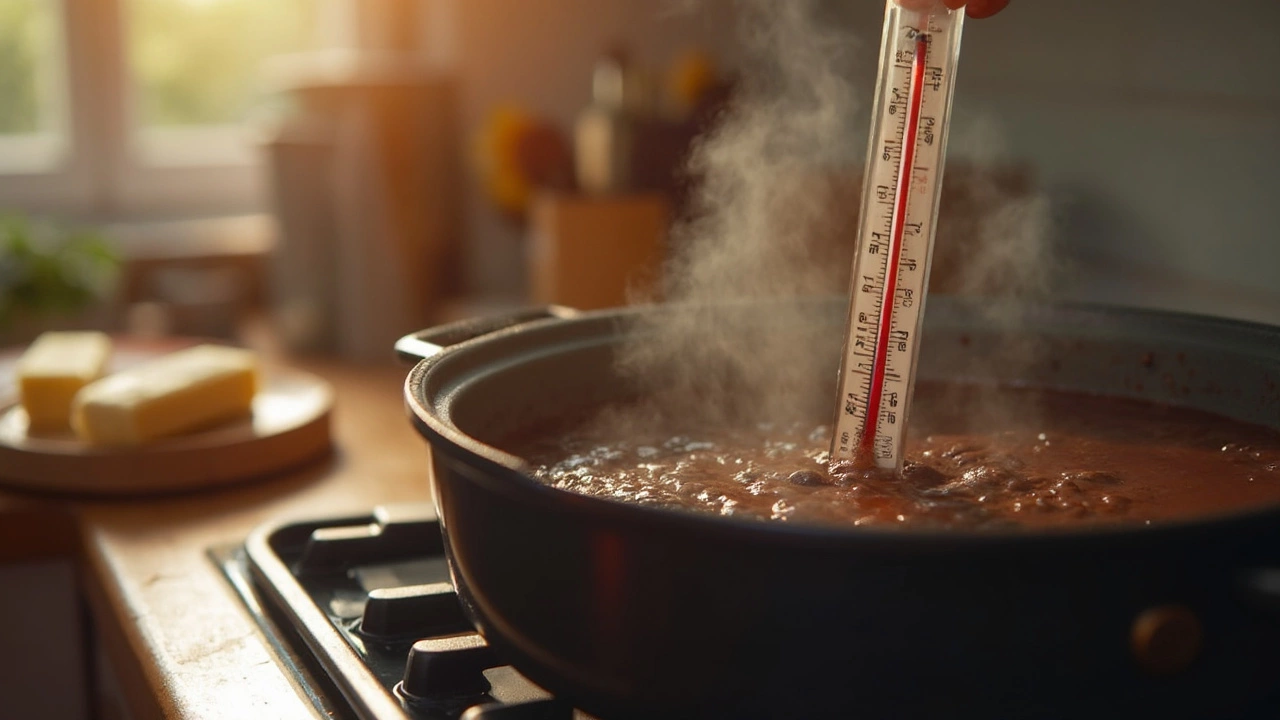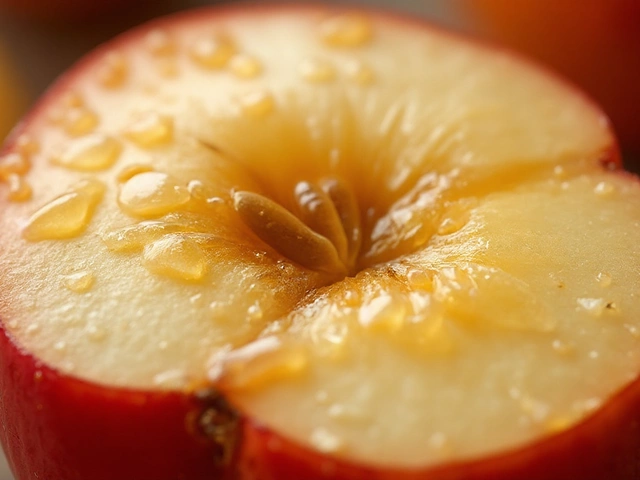
Mmm, fudge. Just saying the word can make your mouth water, right? But what about making it yourself? There's a lot of debate around whether or not you should stir fudge while it's boiling, and I totally get it—perfecting that smooth, creamy texture ain't as easy as it sounds.
So, to stir or not to stir? It’s all about timing. When you're just starting out, it’s tempting to keep that spoon busy to avoid any crusty bits. However, if you stir while everything's boiling away, you may end up making things worse with unwanted sugar crystals.
Letting those sugar crystals get out of control is a nightmare, trust me. Ever had grainy fudge? It’s no fun. The key is to watch the mixture closely and wait until it hits that magic temperature, then stir like your fudge depends on it (which it does!). In this journey to fudge perfection, patience is as crucial as those fancy candy thermometers.
- The Basics of Boiling Fudge
- Consistency: When to Stir, When Not To
- The Science of Sugar Crystals
- Common Mistakes to Avoid
- Patience and Precision in Fudge Making
- Tips for Perfectly Smooth Fudge
The Basics of Boiling Fudge
When it comes to making fudge, understanding the boiling process is key. At the heart of a good fudge recipe is the perfect boil. This stage sets the foundation for that smooth, melt-in-your-mouth texture we're all craving.
First things first—you need to get your ingredients right. Most classic recipes call for sugar, butter, and milk. The magic happens when these ingredients reach a boil, but it’s not as simple as turning up the heat and walking away.
The boiling point typically hovers around 234°F to 240°F (that’s about 112°C to 116°C for those who prefer Celsius). This stage is often called the 'soft-ball stage' because a small amount of the syrup dropped into cold water will form a ball that won't easily flatten between your fingers.
Now, why is this temperature so important? It’s all about that sugar concentration. If your boiling fudge goes under this temperature, you might end up with a fudge that’s too soft and never firms up. Go over it, and you’re in for a dry, crumbly disaster.
Tending to the fudge while it boils is like babysitting a temping toddler. You gotta be patient and consistent. Use a good candy thermometer, and don’t let distractions steal your focus. It sounds intense, but it’s totally worth it when you bite into that perfect fudge piece.
In the world of candy-making, every second counts, so keep your eyes on that thermometer! Oh, and stir only if the recipe specifically says so—otherwise, you risk making fudge with a gritty texture due to crystallization. Follow this routine, and soon, you'll master the fine art of fudge making!
Consistency: When to Stir, When Not To
Alright, let's tackle the big fudge question: when exactly should you stir? This is where things get interesting. Stirring at the wrong time can mess up everything, leaving you with fudge that’s more like a sugary hunk than a deliciously smooth square.
Start by mixing your ingredients thoroughly before you even hit that heat. As your mixture begins to boil, resist the urge to stir. Sounds crazy, right? Well, here’s the thing: stirring during the initial boiling phase can lead to sugar crystals forming, and nobody wants gritty fudge.
So, when's the right moment to stir? Watch the temperature! Once it reaches around 234°F to 240°F (the magical ‘soft ball’ stage), you can take it off the heat. But hold on—don’t just start stirring like a mad person. Let it cool a bit first, until it drops to about 110°F. This cooling phase keeps your fudge from seizing up and turning into sugar land.
Once it’s hit that sweet spot, stir firmly until it thickens and loses its gloss. This is your moment! Stirring now ensures a melt-in-your-mouth texture rather than a crunchy sugar bite.
Here’s a little cheat sheet:
- Before boiling: Mix thoroughly for even consistency.
- During boiling: No stirring. Keep those crystals at bay.
- Post-boiling: Stir firmly but let it cool down first.
Getting this timing right is your golden ticket to making fudge that’s perfect every time. If you’re still unsure about the exact temperatures, a digital thermometer can be your best kitchen buddy here. And once you've nailed this part, you'll be well on your way to fudge that's smooth and practically irresistible.
The Science of Sugar Crystals
Ever wondered why candy-making tips stress over sugar crystals so much? Well, when it comes to making the perfect fudge, understanding these crystals is essential. It's like having the secret decoder ring to smooth, melt-in-your-mouth perfection.
Sugar crystals are basically the building blocks of all things sweet and delicious, but get too many of them, and your boiling fudge goes from dreamy to disaster. When you're boiling sugar, it dissolves into the water, creating a sugary syrup. As this syrup cools, sugar molecules want to recrystallize.
Now, here's the tricky part: if they're given a chance to cluster together while you're cooking, you'll end up with that gritty texture nobody's fond of. The solution? Patience and careful stirring at the right time. Nailing that smooth texture means allowing sugar to crystallize only after it has cooled down exponentially.
To help keep things under control and avoid premature crystallization:
- Avoid stirring while the mixture is around that critical boiling stage unless the recipe specifically calls for it.
- Cooking it to the right temperature is super essential. We're talking candy thermometer territory—bright nerd glasses optional!
- Prevent those undissolved crystals on the side of the saucepan by using a clean brush dipped in water to scrape them away gently.
Stirring your fudge only when the instructions say is golden advice, keeping those pesky sugar crystals at bay. Want a fun fact? Professional fudge makers who've conquered the art swear by a sugar concentration between 85-90% after boiling. It's a tried and true standard for ensuring the smoothest texture ever.

Common Mistakes to Avoid
Getting fudge just right can be a bit tricky if you're not mindful of what’s happening in your pot. Let's save you some headache with a list of common missteps people make when boiling fudge.
Not Watching the Temperature: First off, a candy thermometer isn't just a fancy tool; it's a must-have. Fudge typically needs to be boiled to around 234 to 240°F. Missing that mark even by just a couple degrees can turn your boiling fudge into either a soupy mess or a rock-hard disaster.
Stirring at the Wrong Time: Sure, it’s tempting to stir constantly to prevent sticking, but resist that urge! Stirring during the actual boil can lead to those pesky sugar crystals, making your fudge gritty. Wait until it reaches the right temperature and you're ready to cool to give it a gentle stir.
Skipping the Cooling Period: Oh, patience. I know it’s tough, but skipping or skimping on cooling won’t do you any favors. You need to let your fudge cool undisturbed to about 110°F before you start stirring again. This cooling time helps those sugar crystals behave and keeps your fudge nice and creamy.
Using the Wrong Ingredients: Quality matters, folks. Cheap or low-quality ingredients can mess with the texture and flavor. Use good chocolate, real butter, and fresh cream to make your fudge truly stand out.
Rushing the Process: This is not the time for speed cooking. Rushing the boiling and cooling can make the consistency go wonky. Take your time, and your fudge will thank you.
Setbacks happen, but armed with this knowledge, you're much more likely to score that perfect, creamy fudge without the drama!
Patience and Precision in Fudge Making
Making fudge is more of an art than a science—actually, scratch that—it's a perfect mix of both. You need both patience and precision to nail this sweet treat. Starting with patience, you’ve got to give the sugar enough time to dissolve completely before you crank up the heat. Rushing through this stage is a big no-no if you want that creamy consistency.
As you move through the process, keeping an eye on temperature is a big deal. A simple pen-and-paper thermometer isn't going to cut it; invest in a reliable candy thermometer. You're aiming for a specific temperature range—usually around 234°F to 240°F (or 112°C to 115°C). It's known as the 'soft ball stage' in candy-making lingo. Too hot, and your fudge becomes dry and crumbly. Too cold, and well, it's a goopy mess.
Once you hit that sweet spot, patience pays off again. You’ve got to let it cool undisturbed. This part’s crucial because jumping the gun and stirring too early is a rookie mistake. Watch out for that glossy finish on top—that’s your signal that it's ready for some serious stirring action.
Here's where precision comes into play again: Timing your stirring is key. When the surface cools just right, beat it until it turns matte. It might take a bit of elbow grease, but that smooth, luscious texture is worth every second of effort.
So, while you might be tempted to rush through these steps or cut corners, remember the golden rule of fudge-making: good things come to those who wait. And measure. And stir with intention!
Tips for Perfectly Smooth Fudge
Creating that dreamy, silky fudge everyone raves about isn't just about luck—it's about knowing the right tricks. First up, let's talk ingredients. Always go for the freshest options you can find. Using high-quality chocolate and fresh butter makes a world of difference in your fudge recipes.
Temperature is king when it comes to boiling fudge. Keep that trusty candy thermometer handy and make sure it's reading 234°F to 240°F (that's 112°C to 116°C). This is known as the 'soft-ball' stage, and missing it can mean the difference between creamy success and a crumbly disaster.
Once boiling, resist the urge to stir. Constant stirring can trigger those pesky sugar crystals. Instead, just let it simmer in peace until it hits that magic temperature.
Timing your cooling is another crucial step. After taking your fudge off the heat, let it sit until it cools to about 110°F. Start stirring it only then. This is when it goes from a sticky mess to a uniformly grainy mixture that ultimately transforms into smooth bliss.
Let's sprinkle in some precision here. Notice tiny lumps forming? This signals the start of crystallization—a good sign you're on track.
It's not all blind faith and hope, though. Adding a teaspoon of corn syrup or butter while cooking helps prevent unexpected crystallization. Trust me; these little helpers keep your fudge making journey smooth sailing.
Lastly, make sure your tools are ready for action. An extra set of hands—or spatulas—can be helpful when transferring the hot mixture into a prepped pan. And don’t forget to line that pan with parchment paper for easy removal.
If you follow these steps, you'll be turning out perfectly smooth fudge that's not just camera-ready but melt-in-your-mouth delicious every single time.





